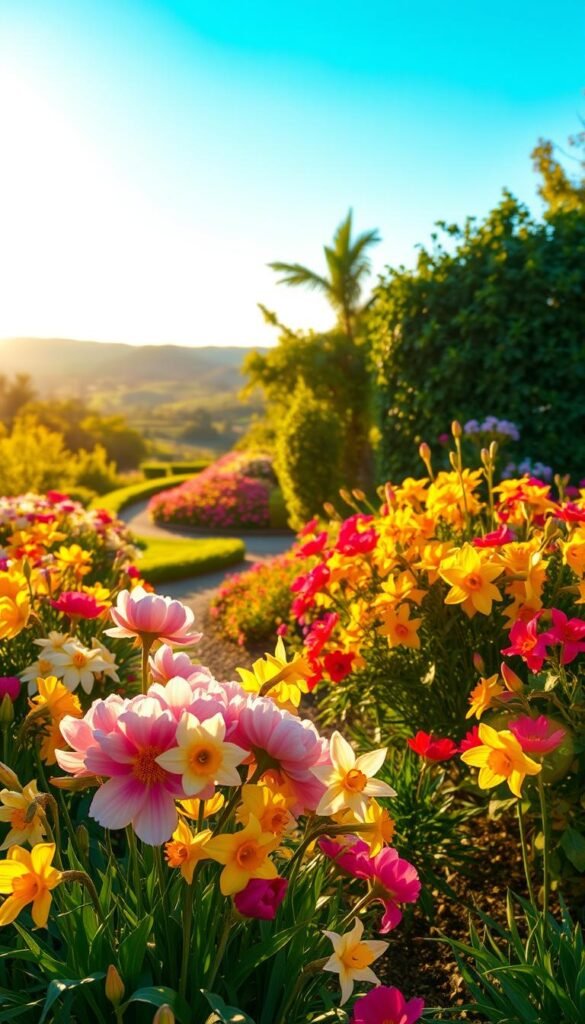Transforming your yard into a lively retreat starts with bold choices. By selecting plants that burst with energy, you create spaces that feel alive. Annuals like zinnias and perennials such as coneflowers offer vibrant hues that shift with the seasons, ensuring your view stays fresh.
These lively blooms do more than please the eye—they invite nature’s helpers. Hummingbirds dart between red salvias, while bees buzz around purple lavender. Even beginners can thrive with low-maintenance options like marigolds or black-eyed Susans.
Design plays a key role in maximizing impact. Pairing tall sunflowers with creeping phlox adds depth, while contrasting textures like velvety lamb’s ear beside spiky irises create intrigue. Your space becomes a canvas where every petal tells a story.
Whether you’re refreshing a patio planter or reimagining an entire yard, harmony comes from balance. You’ll learn how to blend shades that complement your home’s exterior and arrange plants for year-round interest. The result? A welcoming haven that mirrors your personality and nurtures local wildlife.
Embracing a Colorful Garden: An Overview
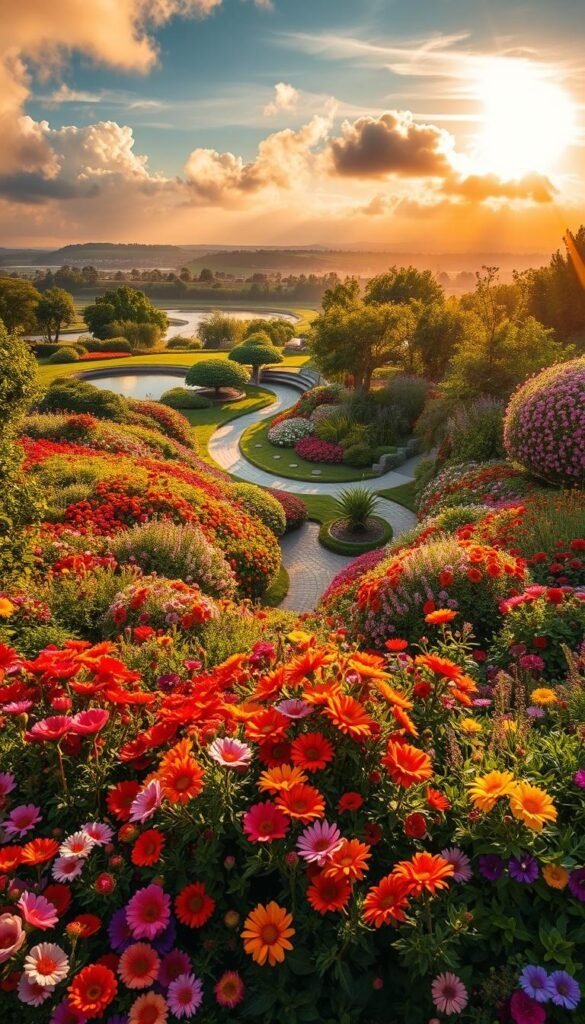
A lively outdoor space thrives when you harness nature’s palette. Bright blooms like coneflowers and wildflowers turn your yard into a living canvas that shifts from spring’s pastels to summer’s bold bursts. This approach isn’t just about looks—it creates habitats for hummingbirds and butterflies while adding joy to your daily routine.
You’ll love how low-effort options like zinnias or black-eyed Susans deliver big impact with minimal fuss. Native plants adapt effortlessly to local soil, making them smart picks for busy gardeners. Pairing textures—like feathery cosmos with glossy daylilies—adds depth that keeps the eye moving.
“The right mix of hues can make even a small area feel expansive,” notes one landscape designer. Focus on plants that bloom at different times to maintain interest year-round. For example, early-blooming lupines give way to late-season asters, ensuring your space never feels stagnant.
Want more ideas? Explore our guide on elevating your space with a gardening. Remember, success lies in choosing varieties that match your climate. Test sun-loving marigolds in hot zones or shade-tolerant impatiens under trees. Your efforts will reward you with a thriving ecosystem that’s as functional as it is beautiful.
Understanding Your Outdoor Space and Layout
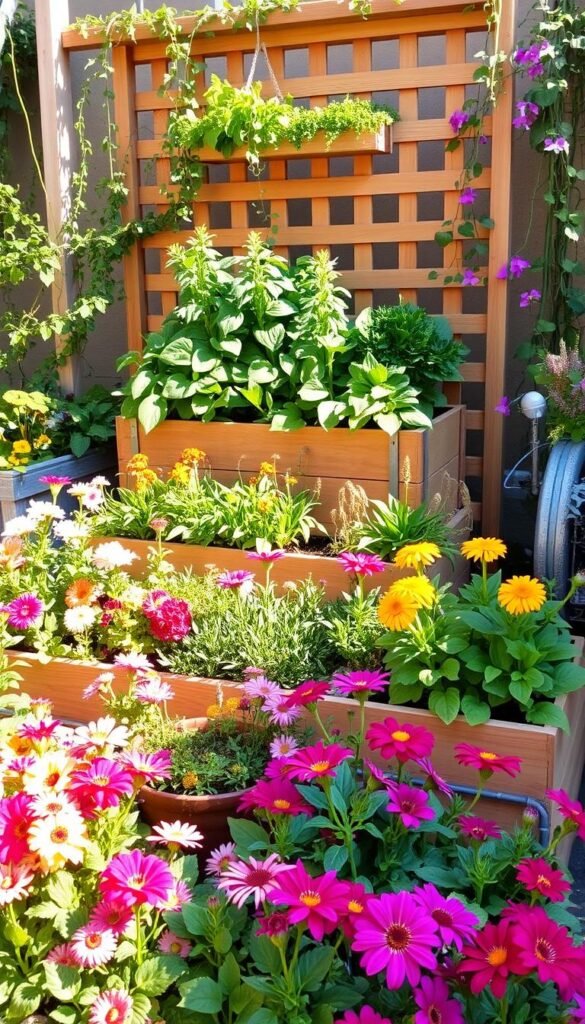
Your outdoor oasis begins with smart spatial awareness. Take time to assess your yard’s unique features—sun patterns, soil quality, and existing structures. This knowledge helps you craft a design that works with nature rather than against it.
Maximizing Small Areas with Clever Design
Limited square footage? No problem. Layer plants by height—tall foxgloves behind medium-height salvias, with creeping thyme up front. This trick creates depth, making your area feel larger. Light-colored blooms like white petunias placed farther back visually expand the space.
Consider sightlines when arranging displays. Place showstoppers like dwarf sunflowers near seating areas or pathways. For more ideas to transform even compact yards, explore creative solutions that blend form and function.
Leveraging Vertical and Container Gardening
Walls and fences become prime real estate with climbing nasturtiums or vertical herb pockets. A simple trellis dotted with morning glories adds height without eating floor space. Containers offer similar advantages—group varied pot sizes for dynamic arrangements.
Rotate portable planters to chase sunlight or create seasonal focal points. Try mixing textures: spiky dracaena with trailing ivy in matching pots. Discover colorful container combinations that adapt as your needs change. Remember—good design turns constraints into creative opportunities.
Crafting a Seasonal Color Palette
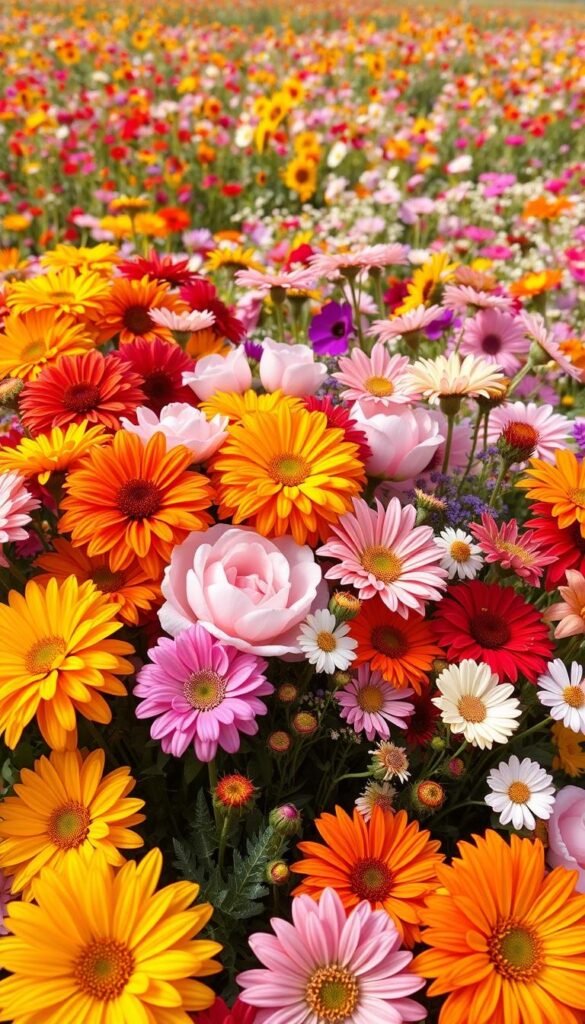
Your landscape becomes a living painting when colors work in harmony. Start by picking a dominant color that matches your home’s style—maybe fiery red geraniums or serene blue hydrangeas. Pair it with neighbors from the opposite side of the wheel, like orange marigolds beside purple salvias, for eye-catching contrast.
Choosing Primary and Complementary Colors
Think of your primary hue as the star of the show. Soft pinks and yellows create calm energy, while bold corals demand attention. Add depth with plants that bloom in staggered seasons—early spring crocuses followed by late summer dahlias keep the show running.
For low-maintenance options that shine year-round, explore raised bed gardens. They let you control soil quality while offering easy access to rotate variety as seasons shift.
Blending Foliage and Bloom for Depth
Leaves are secret weapons in your palette. Dusty miller’s silver foliage makes red roses pop, while burgundy heuchera leaves deepen pink petunias. Mix textures too—glossy camellias beside fuzzy lamb’s ear add tactile intrigue.
Remember: nature’s transitions matter. Pair golden autumn grasses with purple asters for a fiery finale. Your space will flow seamlessly from one season’s blooms to the next, creating endless visual stories.
Expert Techniques for Layered Planting
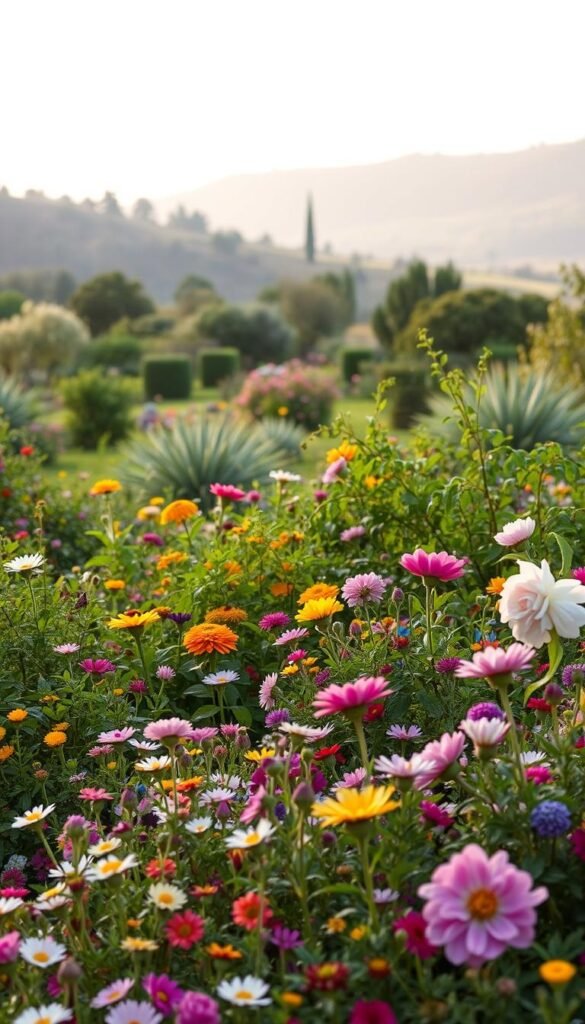
Layered planting transforms flat spaces into living tapestries. By combining plants with different growth habits, you build depth that delights the eye at every level. This method ensures your space stays lively as seasons change.
Mixing Perennials and Annuals for Continuous Bloom
Perennials like daylilies form the backbone of your design, returning reliably each year. Pair them with annual petunias or snapdragons that bring fresh energy every spring. This mix guarantees bursts of color from early buds to autumn’s last blooms.
Place taller varieties toward the back of beds, medium-height plants in the middle, and trailing types along edges. “Think of it as building a floral staircase,” suggests landscape pro Maria Torres. “Each layer supports the next, creating harmony.”
Elevating Your Space with Raised Beds and Borders
Raised beds give you control over soil quality while adding structure. They make layering simpler—tuck creeping thyme along the front edge, then build upward with coneflowers and ornamental grasses. Defined borders keep aggressive spreaders in check.
Try the thriller-filler-spiller formula for containers. A bold canna lily (thriller) pairs with fluffy alyssum (filler) and cascading sweet potato vine (spiller). This approach works equally well in ground-level beds, ensuring visual balance through every phase of growth.
Enhancing Visual Impact with Containers and Hanging Baskets
Breathing new life into your outdoor areas requires creative solutions that adapt as quickly as your imagination. Containers and hanging baskets let you play with space like a sculptor molds clay—adding depth where flat surfaces dominate and introducing movement through strategic placement.
Using Versatile Containers to Create Movement
Window boxes brimming with petunias or ceramic pots hosting bold dahlias become movable masterpieces. Rotate them weekly to catch shifting sunlight or cluster three sizes together for instant visual rhythm. “Containers are the ultimate design cheat code,” says urban gardener Luis Rivera. “They let you test tropical elements in chilly zones or showcase seasonal stars without uprooting existing beds.”
Try pairing angular planters with trailing lobelia to soften edges. Elevate smaller pots on overturned crates for staggered heights that guide the eye. For extra personality, add hand-painted accents through DIY garden art projects.
Integrating Hanging Baskets for Added Dimension
Suspended displays transform overlooked vertical space into floral theaters. Hang fuchsia baskets at eye level along walkways or mount iron hooks at varying heights on pergolas. This approach works wonders for compact patios—ivy spills downward while upward-facing blooms like begonias reach for the sky.
Mix textures by combining velvety million bells with spiky asparagus fern. Water gently but thoroughly—their elevated position dries soil faster than ground-level plantings. With baskets, even shaded corners under eaves can host shade-loving impatiens, proving no area is too challenging for greenery.
Selecting the Best Colorful Plants and Blooms
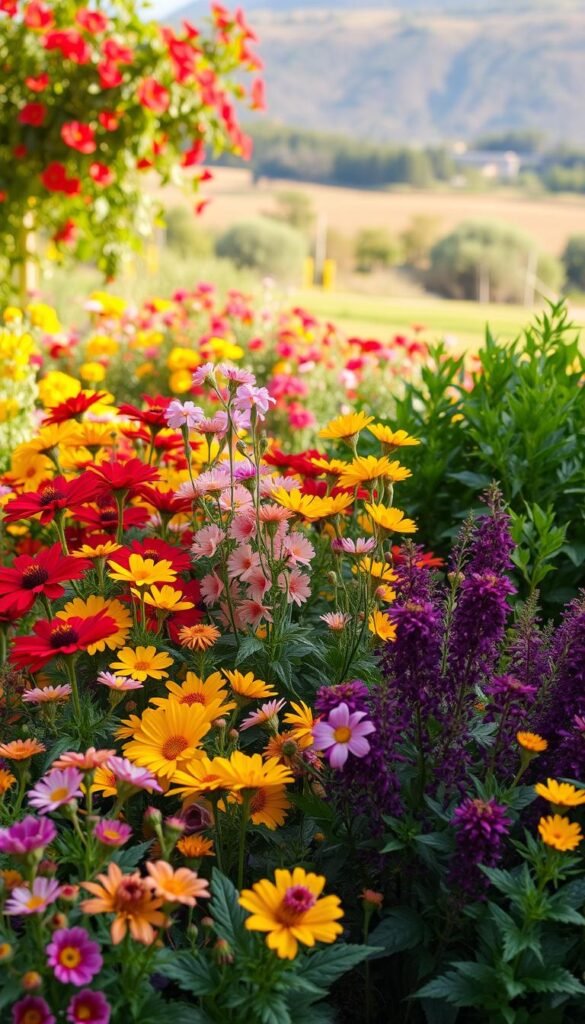
Choosing the right plants turns your outdoor area into a dynamic showcase of nature’s artistry. Focus on varieties that deliver bold pigments and adapt to your climate. This ensures your space remains lively through shifting seasons while supporting local ecosystems.
Spotlighting Vibrant Annuals and Iconic Perennials
Annuals like ‘Funfair Mix’ Zinnias explode with confetti-like patterns, blooming nonstop until frost. Their low-maintenance nature makes them perfect for beginners. Pair them with long-lived perennials like ‘Cheyenne Spirit’ Coneflower—its sunset-colored petals attract butterflies from June through September.
For early spring drama, ‘Coral Charm’ Peony delivers glowing semi-double flowers. Its yellow stamens become bee landing pads, creating a buzzing hub. Discover more most colorful plants that thrive in your region.
Incorporating Diverse Flowers for Dramatic Color
Unusual picks like ‘Green Twister’ Coneflower add intrigue with green-purple petals. These conversation starters work well beside classic red roses or white hydrangeas. In shaded corners, ‘Kaleidoscope’ Kalmia offers pink-red blooms that hummingbirds adore.
| Plant | Color Features | Bloom Time | Sun Needs |
|---|---|---|---|
| ‘Wild Scarlet’ Bee Balm | Fiery red clusters | June – October | Full sun |
| ‘Vanilla Fraise’ Hydrangea | White-pink cones | July – September | Partial shade |
| ‘Queen Victoria’ Lobelia | Red flowers, purple foliage | May – August | Full sun to shade |
Mix textures and heights for maximum impact. Tall ‘The Impressionist’ Roses (orange-pink blooms) contrast beautifully with trailing lobelia in patio container gardening setups. This layering technique ensures every inch of your space contributes to the visual story.
10 Flower Garden Aesthetic Tips for a Vibrant, Colorful Landscape
Creating an inviting outdoor retreat becomes simpler when you learn from those who’ve mastered the craft. Seasoned growers emphasize balancing creativity with practicality—strategic color placement paired with smart plant combinations ensures your space stays lively through every season.
Insights from Expert Gardeners
Top designers recommend starting with a base of native plants. These hardy varieties adapt to local conditions while supporting pollinators. “Layer textures and heights to create depth,” suggests landscape pro Elena Martinez. “A mix of spiky salvias and mounding geraniums adds drama without clutter.”
Real-life Success Stories and Inspirations
Urban gardener Marcus Tran transformed his tiny balcony using vertical pockets and hanging baskets. By combining trailing lobelia with compact marigolds, he crafted a cascading display visible from the street. Another grower saved money by repurposing old containers—check our guide to budget-friendly home gardening ideas for similar inspiration.
Your journey to a thriving landscape starts with small, intentional steps. Whether you’re refreshing pots or redesigning beds, these proven methods help you craft spaces that bloom with personality and purpose.

